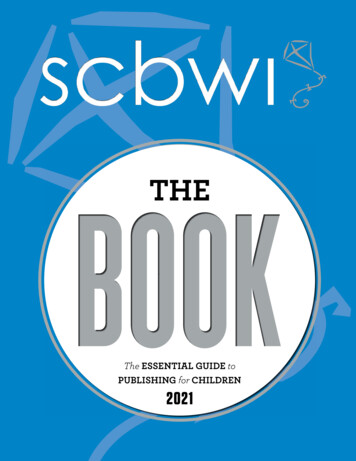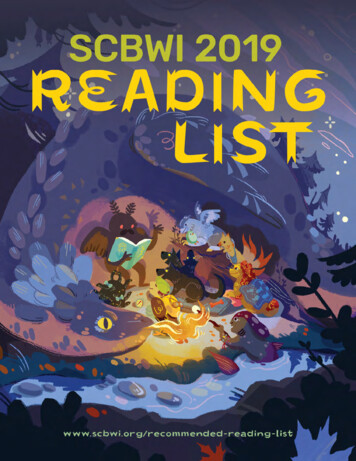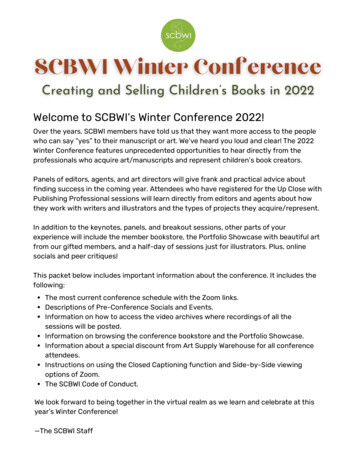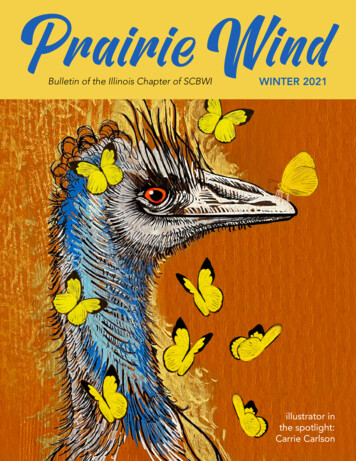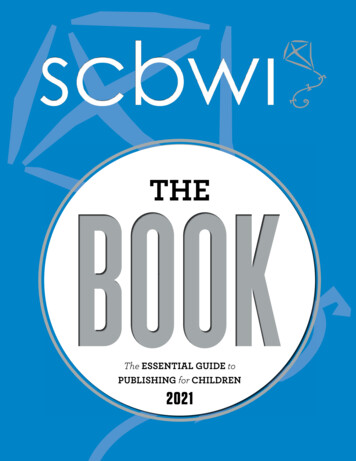
Transcription
THEThe ESSENTIAL GUIDE toPUBLISHING for CHILDREN2021
WELCOME TOTHE BOOK: THE ESSENTIAL GUIDETO PUBLISHING FOR CHILDREN.This book is the crown gem of the Society of Children’s Book Writers and Illustrators publications. It contains virtually all the information you willneed about writing and illustrating for the children’s book market. It will help you chart your creative work from inception all the way through theprocess of publishing and marketing.THE BOOK includes the latest market reports, articles on social media, discussions of emerging publishing options, and up-to-the-minute directoriesof everything from agents to book reviewers to relevant websites. Time-sensitive material contained in THE BOOK is updated regularly on our website,scbwi.org.The SCBWI staff takes great pride in presenting you with this invaluable tool that will optimize your career, whether you are already well published ora newcomer to the field. Use it as your primary reference and workbook.Don’t hesitate to contact us if you have any remaining questions. We wish you great success in the children’s book field and hope that THE BOOK willguide you along your creative path.With all best wishes,Lin Oliver Executive DirectorEXECUTIVE EDITOR: Kim TurrisiASSISTANT EDITOR: Sarah Diamond & Kiana MartinART DIRECTOR: Sarah BakerINTERIOR DESIGN: Meagan BennettFOLLOW US ON TWITTERLIKE US ON FACEBOOKWWW.SCBWI.ORG@SCBWI2021, SCBWI THE BOOK: ESSENTIAL GUIDE TO PUBLISHING FOR CHILDREN. 2021 SOCIETY OF CHILDREN’S BOOK WRITERS & ILLUSTRATORS. Published by Societyof Children’s Book Writers and Illustrators, 6363 Wilshire Blvd. Suite 425, Los Angeles, California 90048. Printed and bound in the United States ofAmerica. All rights reserved. No part of this book may be reproduced in any form or by any electronic or mechancial means including information storageand retrieval systems without written permission from the publisher. This publication is intended for the personal use of SCBWI members only.It may not be used, sold or lent for any purpose, commercial or otherwise.
CONTENTSPREPARING & SUBMITTINGYOUR WORKFrom Keyboard to Printed Page. 7The Query Letter. 11The Synopsis. 13SCBWI Illustrators Guide. 15Jumpstart Your Creative Career. 21Prize-Winning Portfolio. 23Creating Picture Book Dummies. 25Demystifying Digital Dummies. 27You’re Hired to Illustrate Your First Children’sBook: What Comes Next?. 29From the Editor’s Desk: Editorial Facts. 31Starting a Critique Group. 33The Give & Take of Critique. 35Mentoring Matters. 39What the Heck is an Informational Book?. 43Nonfiction for Children: Growing and Changing. 45PUBLISHED AND LISTEDAre You Making the Most of Your Virtual Visits?. 49Doing a Video Presentation from Home?. 51Writing a Proposal for Conferences and Festivals.55Bringing Your Backlist Forward. 57SELF PUBLISHINGWhat You Need to Know Before You Self-Publish. 61Self-Publishing: Best Practices. 63Hiring an Illustrator for Your Self-PublishedBook. 67How Good Design Can Elevate Your Book’sAllure. 69Using Kickstarter to Fund Your Self-PublishedBook. 73The Ten Steps of Self-Publishing: A Guidefor Beginners. 75Beware Author Solutions Self-Publishing Scams.79SCBWI EN ESPAÑOLIntroducción. 83Del teclado a la página impresa. 85La carta de presentación. 89Guía para ilustradorxs de SCBWI. 91La organización de un portfolio ganador. 99Del escritorio de la editora. 101SCBWI MARKET SURVEYS2021 SCBWI Market Survey of Publishers ofBooks for Young Readers. 105International Market Survey. 135Edited By. 137Small Press Market Survey. 147Magazine Market Guide. 155Religious Press Market Survey. 167Educational Press Market Survey. 173SCBWI DIRECTORIES &RESOURCESAgents Directory. 183Agented By. 197Finding an Agent: Best Practices. 207Saying Yes to the Rep. 209Freelance Editors Directory. 211A-Z Guide to Publishing in the Digital World . 219Book Producers Directory. 221Book Reviewers Directory. 225International School Directory. 237Writing & Illustration Courses Directory. 239Writing & Illustrating for Children & Teens . 247Grants, Fellowships, Residencies, & Retreats . 253Residencies & Retreats for Writers & Artists . 257
PUBLICIZING YOURPUBLISHED WORKBook Release Checklist. 261100 Ways to Promote Your Children’s Book . 263Grassroots Book Publicity. 265Keeping Your Book Alive. 267Resources for Published Authors &Illustrators . 2717 Steps to Blogging Success. 275International Bloggers: What They Can Do ForYour Book. 279RIP for the Press Release? Not So Fast!. 281Thirteen Kidlit Podcasts to Inspire Your Writing. 283A Podcasting Primer . 285Fifty Kidlit Blogs to Visit Before You Die . 289All About Book Trailers. 293Crafting Your Book Marketing Plan. 297PAL Speaking Opportunities. 299SCBWI SCHOOL VISITSDoing School Visits in the United States. 303Guide to International School Visits. 307Sample Lecture Contract. 309Public Speaking Primer. 311SCBWI LEGAL QUESTIONSPlagiarism. 315Copyright for Writers & Illustrators. 317SCBWI Sample Children’s Book Contract. 321Archiving Your Work: What You Should Know . 337MY WORKMy Projects. 340Submission Record. 344
SCBWISCBWIPREPARING &SUBMITTINGYOUR WORK2020PUBLICATIONS2021publications guide:GUIDE:theTHEbookBOOK www.scbwi.org www.scbwi.org
FROM KEYBOARD TOPRINTED PAGEedited by Kim TurrisiSo you’ve written a book or an article for young readers? Whether you’resubmitting to agents or have decided to submit directly to editors on yourown, here are the basics on formatting your writing and the process ofsending it out.QUERY FIRSTA query letter is always recommended before submitting a fullmanuscript. This letter is an introduction of you and your story forthe editor. If your manuscript is of interest, the editor will requesta submission. Read “The Query Letter” on page 13 of this guide.AGENTSWhile an agent is not necessary to submit a manuscript to aneditor, many publishers accept only solicited material representedby an agent. When submitting to an agent, here are some thingsyou should know:» Not all agents handle children’s material. Consult the AgentsDirectory on page 143, or online in the “Publications” portion ofthe SCBWI website.» Most agents list their submission guidelines and proceduresat their websites. It is imperative that you research theseguidelines prior to submitting.» The SCBWI recommends that you not deal with agents whocharge upfront for any of their services or have a “reading” fee.SUBMITTING YOUR MANUSCRIPTMost legitimate publishers post their submissions guidelines attheir website. A simple Google search will pull up any publishinghouse to which you might want to submit. Be sure to read theirspecific submission policies prior to sending in a manuscript.To assist you in determining which publishers might be a goodmatch for your writing, the SCBWI offers a resource called “EditedBy,” a house-by-house listing of what editors have publishedrecently. A careful investigation of publishers’ catalogs (availableby request from the publisher), various marketing lists found inwriters’ periodicals, and, most importantly, examination of booksthemselves should indicate to you which publishing houses wouldbe most receptive to your work.Here are some basic suggestions:» Your manuscript should be addressed to the editor whorequested it in response to your query letter. Include a selfaddressed, stamped envelope of the correct size to hold yourmanuscript, with a sufficient amount of postage affixed.» Include a brief cover letter with only information thatis necessary for the editor to know, as it relates to yourmanuscript (e.g., for nonfiction, describe what qualifies youto discuss your subject; for fiction, include any previouspublishing credits). If you are submitting your manuscript inresponse to a previous query, be sure to mention this in yourcover letter.» Keep copies of all correspondence.» Unless you are a professional illustrator, do not includeillustrations with your picture book manuscript. An artdirector will choose an illustrator that suits your work.» Do not attempt to indicate where you would like illustrationsto be placed in your picture book story, or what they shouldportray. This is the job of the art director and the illustrator.» While not all editors will do so, you may include a selfaddressed, stamped envelope to encourage the acknowledgmentof your manuscript.A decision on your manuscript may take six months or more.Some editors are slower to respond than others. If you have nothad a response at the end of three months, send a polite letteror email of inquiry to the editor and ask about the status ofyour manuscript.Submitting a manuscript to several editors at the same time (apolicy called “multiple submissions”) is sometimes frowned uponby editors, but if you choose to do so, you must notify the editorupfront. Simply include a sentence in your cover letter statingthat “this is a multiple submission.”
8 FROM KEYBOARD TO PRINTED PAGEFORMATTING YOUR MANUSCRIPTHere are suggested guidelines from the publishing industry:» All manuscripts must be typed on 8½ ” x 11” white paper inblack ink.» Use 12-point Arial or Times New Roman.» Double space all manuscripts.» Pages should be numbered consecutively.» The default margin settings that appear in a new Microsoft Worddocument are acceptable. If you are setting margins manually,use a 1-inch or 1.25-inch margin on each side of the page.» Do not submit electronically (i.e., email) unless the editor oragent specifically requests you do so.The format of the first page might look something like thepage below.GENRE# OF TYPEDTYPICALPAGESAGEBOARDBOOKS½–1UNDER3National GeographicLittle Kids Look &Learn seriesPICTUREBOOKS2–33–8Goodnight Moon,Heart and Soul, ThePolar Express, s Tea Party,Marley: The Dog WhoAte My Homework,Nate the GreatCHAPTERBOOKS40–607–9Captain Underpantsseries, Clementineseries, Magic TreeHouse seriesMIDDLEGRADE100–2508–12Hank zipzer series,Diary of a Wimpy Kidseries, Merci SuarezChanges Gears,Twins, Prairie Lotus,Amal UnboundYOUNGADULT (YA)NOVELS200–35012 ANDUPThe Hate You Give,The Poet X, ShoutNONFICTIONLENGTHVARIESBY AGEGROUPBooks byCandace Fleming,Steve Sheinkin,Pamela TurnerPOETRY FORYOUNGERREADERS*15–40Animal Snackersby Betsy LewinYour NameYour AddressCity, State ZIPYour Telephone NumberYour Email AddressTITLE IN ALL CAPS (halfway down page)By Your Name2021 PUBLICATIONS GUIDE: THE BOOK www.scbwi.orgYour story begins here.POETRY50–150FOR OLDERREADERS**In manuscript form, one poem per page.1NUMBER OF MANUSCRIPT PAGESWhile there are no specific requirements, here are current markettrends for the genres listed below. We recommend that you begin byvisiting a bookstore (not a library) to see what books are currentlybeing offered by publishers.Agents and editors seek good writing. If your voice, plot, andcharacters grab them, they will help you decide what genre bestdefines your book. Research prior to submitting will help you knowwhere your specific story falls.SAMPLE TITLESBooks byShel SilversteinRESPONDING TO EDITORIAL FEEDBACKIf you receive a personal response from an editor with revisionsuggestions, but no formal contract, respond by thanking the editorfor the time and interest given to your manuscript. Consider theeditor’s suggestions carefully. If you decide that your manuscriptwould be improved by the editor’s suggestions, and complete therevisions, you are professionally obligated to send that manuscriptback to that editor.No editor spends time writing a detailed editorial letter withoutexpecting to see the manuscript again. Mention in the letteraccompanying your revised manuscript that you have followed theeditor’s suggestions for revisions.MAGAZINESMost magazines for young readers publish their submissionguidelines at their websites. Many include their editorial deadlinesand calendars so that you can submit work that is appropriate for
FROM KEYBOARD TO PRINTED PAGE the theme of a specific issue. Be sure to research the submissionpolicies for the specific publication you are interested in prior tosubmitting. Here are some general guidelines:» Include the word count on the first page of your articlesubmission.» Magazine publishers generally do not acknowledge receipt ofarticles.» It is appropriate to inquire about your article after two monthshave passed.» Some magazines, especially in the religious field, will acceptmultiple submissions.» Magazines plan issues far in advance; it is important to keep thisin mind when submitting seasonal material.» Some magazines pay upon publication. They may hold yoursubmission for a considerable length of time before eitherprinting or returning it.» Most children’s magazines do not pay large amounts for theirmaterial, but can provide the novice writer with valuableexperience.9
THE QUERYLETTERby Carla Killough McClaffertySometimes the same author who is capable of writing a book, short story, orarticle is filled with anxiety and dread when considering what to write ina query letter. If you are one of these people, I hope that by the end of thisarticle you will be free from the qualms of the query.Part of the confusion about what a query letter should say comes fromthe fact that there are different genres. An effective query letter thatrepresents a nonfiction magazine article will be very different from onefor a YA novel. Then within each genre, each manuscript is unique, whichmeans that every query letter must be one-of-a-kind.The most important thing to understand, regardless of whether themanuscript is fiction or nonfiction, is that a query letter has one purposeand one purpose only: to cause the editor or agent to want to read yourmanuscript or book proposal. That’s it. Period. The writer’s job is to crafta letter that will create that desire.Think of a query letter as a sales tool that can market a product. Awriter’s product is a group of words that tell a story. The query letteris an advertisement that should make the reader want to know moreabout the product. In some ways, that might sound harsh. It mayeven contradict the “touchy, feely, love of books” reason most peoplebecome writers. Yet writers must understand that they work in a creativebusiness. The process of writing is creative, but publishing is a business.In order for a writer to get the words they have lovingly crafted into thehands of children to enjoy, they need to market their product. Often thatmarketing plan includes a query letter.A query letter should fit on one single page—never longer. It shouldbe clear and concise so that a busy editor gets the meaning of the letterin one quick read. A query letter is a business letter. In it, the writer isnot looking for a friend; they are looking for an editor or agent. Sincethe goal is to create a professional relationship, the tone of the lettershould not be overly chummy or personal. When an editor or agent readsa query, their impression should be that the author is a professionalwriter, not an amateur who is dabbling with a hobby. Part of being aprofessional is following the guidelines found in market guides such asChildren’s Writer’s and Illustrator’s Market. Each publisher is specific aboutwhat they want to see in a submissions package, so writers should sendthe requested items. For both fiction and nonfiction, what each companyrequests varies widely. Some book publishers ask for a query only, whileothers request a query, outline, synopsis, and sample chapters.So what makes an effective query letter? Although each letter willbe different, each one should contain four basic parts: hook, summary,biographical information, and a closing.HOOKA writer wants to hook their readers with the first sentence of amanuscript. Likewise, the first line of a query letter should hook thereader. Think of this section as a sound bite, not the entire newscast.Find an original, creative way to begin the letter using somethingrelating to the manuscript that makes the reader want to find out more.The only exception to beginning your query with a hook would be ifthe writer has personally met the editor or agent. In that case, it couldbegin with something like, “I enjoyed meeting you recently at theArkansas SCBWI conference and appreciate your willingness to considersubmissions from attendees.” Editors are usually nice people who wouldlike for writers they have met personally to succeed, so they will considersuch a query carefully. If a query begins with a meeting reminder, itshould be brief, then go immediately to the hook.SUMMARYIn this section, summarize what your manuscript is about in threeor four sentences. For novels, this does not mean the plot points ofyour novel. It means an overview that includes the setting, characters,conflict, and how the novel is different from other similar novels. Fornonfiction, it means an overview of how the material will be handled,the availability of photos, access to experts, and facts or statistics thatindicate how many potential readers may be interested in such a book.As in every section of the query letter, the summary details must beexplained in an interesting, exciting way.BIOGRAPHICAL INFORMATIONIn the hook and summary sections of a query letter, the writer’sgoal is to convince the editor or agent to read the offered manuscript.In the biographical information section, the goal is to convince the
12 THE QUERY LETTEReditor or agent that the writer of the query is the only one who couldsuccessfully write the manuscript described. In this brief section, thewriter must highlight the areas of their life that make them an experton the topic. For example, let’s say a writer is a physical therapist andshe spends two weeks every summer volunteering at an archaeologicaldig. If that writer was marketing a novel she had written about an iceskater who undergoes months of rehabilitation to overcome an injury,then she would highlight the fact that she had been a physical therapistfor twenty years and had helped many young athletes recover from theirinjuries. However, if that same writer was marketing a nonfiction bookmanuscript about an archaeological dig, she would not mention thatshe was a physical therapist. Instead, she would highlight her previouswork at the dig.The biographical section is also where publishing credits are listed—best-known ones first. If the writer has signed a contract but the articleor book has not yet been published, they could say something like,“I have an article forthcoming in the May issue of Cricket magazine.”If a writer does not have any publishing credits, they should not callattention to the fact. Instead say, “I am an active member of theSCBWI.”Writers should always present themselves as professionals, even whenthey are just beginning. Never make comments like “This is my firstsubmission to an editor, so I really hope you like it,” or “Six differenteditors have already rejected this manuscript, but I think it is right foryou,” or “I read this to my son’s second grade class and they just lovedit.”2021 PUBLICATIONS GUIDE: THE BOOK www.scbwi.orgCLOSINGBring the letter quickly to a close. It could be something as simpleas “I look forward to hearing from you” or “Would you like to see thecomplete book proposal for Successful Query Letters?” However, if theletter runs too long and needs to be cut down, the closing is where tostart chopping. Although a polite closing is nice if you have the space,they already know why you are writing to them.Finally, the query letter should match the tone of the manuscript.If the manuscript you are marketing is humorous, the query shouldbe humorous. If it is a mystery, the letter should convey a mysteriousfeeling. A nonfiction book about an exciting new discovery shouldexpress a sense of anticipation.Some writers spend months, even years, writing and revising theirmanuscript; then, when it is finished, wonder how they could possiblydescribe their work in a one-page letter. It is accomplished when awriter works on the query just as they did the manuscript: Write a roughdraft, then revise, revise, and revise again—until it is as good as youcan make it. Any writer can write an effective query letter. After all, noone believes in a manuscript more than its author.TIPS FROMINDUSTRY INSIDERSWhile every query letter is different and should reflect yourpersonality, there are some tried and true dos and don’ts whenyou write one. We spoke with many publishing professionals,and following are the top ten dos and don’ts when writing yourquery letter.Dos1. Keep it simple! If it’s more than a paragraph, most editors/agents will skip it.2. Be friendly, but professional. No need to be super serious, butremember that you and the reader are not personal friends.3. Include a one- or two-sentence teaser for your story. Think ofit as advertising copy, not a plot summary. (Look at flap copy forexamples.)4. Close with a short bio and include any publication credits.5. Know how to categorize your book in the correct age groupand genre.6. Research who you’re submitting to—what kinds of books(subject matter, age level, genre, etc.) they publish, what they areinterested in (see if you can find interviews they’ve given), etc.7. Let the reader know if you’ve met at a conference or workshop.8. Always include a personalized salutation and get the spellingof their name correct! If you aren’t sure about their gender, omitthe honorific. It is perfectly professional to start a letter with“Dear [First Name] [Last Name].”9. Have a strong opening, something to hook the editor or agent.10. Try to read something an editor has edited or that an agentrepresents so you know their taste.Don’ts1. Don’t open with a question.2. Don’t include marketing plans.3. If an editor or agent passes on seeing your work, do notcontact them asking that they reconsider your query. Yourenergies would be better spent on an editor or agent withunreserved enthusiasm for your project. Similarly, please don’task the editor or agent to provide feedback on your query.4. Don’t mention that your niece, student, child, grandchild, orfriend loves your work. That doesn’t matter—what matters isif it’s good and intriguing and compelling and stands out fromeverything else that’s being published.5. Don’t compare your work to something unprecedentedlysuccessful, like the Harry Potter or Twilight series. Thoseare impossible-to-replicate successes. Find something morerelevant and normal, but still successful.6. Don’t send a picture book manuscript to a teen novel editor.Know editors’ lists and what they acquire before you submit.7. Don’t follow up less than three to four weeks after submittinga project.8. Don’t talk about sequels you have planned.9. Don’t say “I’m a new writer” or “This is the first book I haveever written.”10. Don’t be overly familiar with the editor or agent you aresending a query letter.
THE SYNOPSISby Deborah Fletcher BlumFor some writers, the thought of writing a synopsis, a short summary oftheir book, causes panic, downturned eyes, and heavy sighs. It can be asomber task to whittle one’s beloved story down to its bare essentials. Butit can also be exhilarating. Here are some tips to guide you through the process.Attempt to fit the essentials of your story into a neat package—between one to three pages—though lengths vary depending on theaudience. Synopses (plural based on the Latin root) are often requestedby agents and editors. Writers may or may not be given a word count orpage length guide. Either way, a writer does best to ponder the highs andlows of their story, the main character’s arc, the tone and setting beforebeginning. Then take a deep breath and begin, knowing that there willbe a chance to edit and revise.A GUIDE TO WRITING SYNOPSES:Step 1: Always Use the Third Person Present TenseRegardless of the tense in which the story is written or the voice of thenarrator, a synopsis should always be written in the third person presenttense.Step 2: Write a One-Sentence Character Arc Before StartingWrite a one sentence arc for the main character before starting, and keepthis sentence available for later use, and as a reference guide to keepyou on track.Step 3: Hook the ReaderStart your synopsis with a gripping, one-sentence summary thatcaptivates and mirrors the tone of the story. A mystery may use amysterious question. A synopsis for a middle grade novel or a picturebook might require vocabulary more elevated than that used in the story,but the language should not be too overblown. A tone that evokes thestory itself is best. The hook provokes thought and forces the reader toask: What happens next? It can be the same few sentences used in aquery letter. In fact, the beginning of your synopsis might sound verymuch like the plot-summary paragraph of a query letter.Step 4: Introduce the Main CharacterDescribe the main character’s MOTIVATION, CONFLICT, and GOALS.Highlight the main character’s personality with one or two vividadjectives. This may seem like type-casting, but it a useful tool thatallows the reader to visualize the character quickly.wFor example: Shy but adventurous Katy longs to discover what ishidden in the old chest in the attic that belonged to her grandmother.But first she must gather up the courage to ask her stern grandfather forthe key.Step 5: Construct the Body of Your SynopsisUse paragraphs to write out the main events of each chapter. Or pick outthe high and low points and chart the story’s progression from beginningto end. Major events focus on the rising action and the main character’sconflict or goals, and how they are achieved or not achieved.Keep paragraphs tight. Only details critical for the reader’sunderstanding should be included. Each paragraph must include: anACTION, REACTION, and DECISION by a main character. Include thoughts,beliefs, mistaken beliefs and assumptions, if they are critical to theoutcome of the story.For example: Sam takes Jeremy’s lunch box at recess. Jeremy runs afterhim, falls down and skins his knee. Jeremy decides he will take a paperbag lunch from now on and throw it away.Step 6: Put Character Names in ALL CAPSWhich secondary characters are involved in the major scenes included inthe synopsis? Each new character’s name should be written in all capitalsthe first time it appears, exactly as it appears in the story. Charactersmentioned unnecessarily will only take up valuable space.Step 7: Reveal the EndingTell the story to the end. Even if the story is a mystery, do not bemysterious with the ending. State it clearly and briefly. Devote one totwo paragraphs to the CLIMAX (CRISIS) and RESOLUTION (ENDING).Describe the main character’s final struggle and its outcome. Why doesthis matter? This is the time to state what the main character learns.
14 THE SYNOPSISDon’t keep editors or agents guessing.For Example: In the end, Jess makes peace with her brother, paysback the money she stole from him and ends up with a new best friend.She learns that if you make a mistake, sometimes you get a chance tomake it up to the person.Step 8: Revise and PolishEach sentence must flow and convey the power, excitement, and humorof the story. Use strong adjectives and verbs. Keep revising and editinguntil the synopsis flows and is the length you desire. You may start witha three- to four-page summary and whittle it down to one or two pages.Be patient. The process is a valuable one.Step 9: Remove Extra WordsA synopsis should be quick to read. It must not slow down. It is allexposition, but it must not drag even the tiniest bit. The bare bonesof the story speak for itself now, with no flowery details or quirkydialogue to break up the sentences. Though it is possible that a quoteor two might appear in a synopsis, this would be if the words said by acharacter are themselves part of the plot.Step 10: Check for the Main Character’s ArcYour main character need not change dramatically, but the changeshould be meaningful. Maybe they learn a new way of looking at theworld, overcome a fear or repair a brok
of everything from agents to book reviewers to relevant websites. Time-sensitive material contained in THE BOOK is updated regularly on our website, scbwi.org. The SCBWI staff takes great pride in presenting you with this invaluable tool that will optimize your career, whether y


